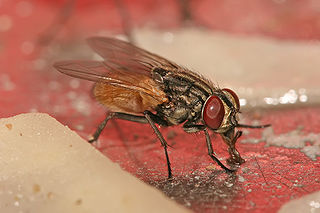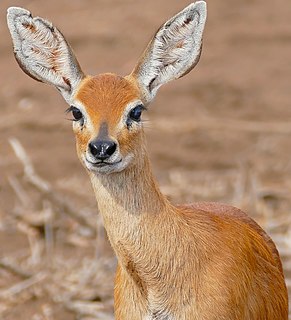
The Integrated Taxonomic Information System (ITIS) is an American partnership of federal agencies designed to provide consistent and reliable information on the taxonomy of biological species. ITIS was originally formed in 1996 as an interagency group within the US federal government, involving several US federal agencies, and has now become an international body, with Canadian and Mexican government agencies participating. The database draws from a large community of taxonomic experts. Primary content staff are housed at the Smithsonian National Museum of Natural History and IT services are provided by a US Geological Survey facility in Denver. The primary focus of ITIS is North American species, but many biological groups exist worldwide and ITIS collaborates with other agencies to increase its global coverage.

Helina is a very large genus from the fly family Muscidae.

Muscidae are a family of flies found in the superfamily Muscoidea.

1075 Helina, provisional designation 1926 SC, is a stony Eos asteroid from the outer regions of the asteroid belt, approximately 34 kilometers in diameter. It was discovered on 29 September 1926, by astronomer Grigory Neujmin at the Simeiz Observatory on the Crimean peninsula. The asteroid was named after the discoverer's son, Helij Neujmin.

Raphicerus is a genus of small antelopes of the tribe Neotragini.
The Catalogue of Life is an online database that provides an index of known species of animals, plants, fungi, and microorganisms. It was created in 2001 as a partnership between the global Species 2000 and the American Integrated Taxonomic Information System. The Catalogue interface is available in twelve languages and is used by research scientists, citizen scientists, educators, and policy makers. The Catalogue is also used by the Biodiversity Heritage Library, the Barcode of Life Data System, Encyclopedia of Life, and the Global Biodiversity Information Facility. The Catalogue currently compiles data from 168 peer-reviewed taxonomic databases that are maintained by specialist institutions around the world. As of June 2021, the Catalogue lists 1,997,284 of the world's 2.2m extant species known to taxonomists on the planet at present time.

The long-tailed mole is a species of mole in the family Talpidae. It is found in China, Vietnam and Myanmar.

The yellow-bellied weasel is a species of weasel that inhabits pine forests in central and eastern Asia.
Erich Martin Hering was a German entomologist who specialised in leafmining insects, He was a curator in the Museum für Naturkunde in Berlin, where his collections of Lepidoptera, Coleoptera, Hymenoptera, Diptera are conserved. His collections of Agromyzidae are shared between MfN and the Agricultural School at Portici now part of the University of Naples Federico II.

The Nag missile, also called "Prospina" for the land-attack version, is an Indian third-generation, all-weather, fire-and-forget, lock-on after launch, anti-tank guided missile (ATGM) with an operational range of 500 m to 20 km. It has a single-shot hit probability of 90% and a ten-year, maintenance-free shelf life. The Nag has five variants under development: a land version, for a mast-mounted system; the helicopter-launched Nag (HELINA) also known as Dhruvastra; a "man-portable" version (MPATGM); an air-launched version which will replace the current imaging infra-red (IIR) to millimetric-wave (mmW) active radar homing seeker; and the Nag Missile Carrier (NAMICA) "tank buster", which is a modified BMP-2 Infantry Fighting Vehicle (IFV) produced under license in India by Ordnance Factory Medak (OFMK).

Phaoniini is a tribe in the fly family Muscidae. It contains the largest Muscid genus Phaonia.
Helina pertusa is a fly from the family Muscidae. It is the type species on the Genus Helina.
Hyocephalidae are a small family of Heteroptera which are endemic to Australia.
Alfred Frank Millidge was a British arachnologist who wrote several works on spiders. One of his best-known might be British Spiders, volumes I and II, which he co-wrote with G. H. Locket. In 1983, he became the first person to describe the spider species Walckenaeria crocea.

Proscopiidae is a family of Neotropical grasshoppers, now placed in its own superfamily, the Proscopioidea. Some species may be known as stick grasshoppers or jumping sticks.
Glyptothorax alaknandi is a species of catfish that was first described by Tilak, 1969. Glyptothorax alaknandi is a species in genus Glyptothorax, family Sisoridae and order Siluriformes. IUCN categorise the species as least concern globally. No subspecies are listed in Catalogue of Life.

Glyptothorax botius is a species of catfish that was first described by Hamilton 1822. Glyptothorax botius is a species in genus Glyptothorax, family Sisoridae and order Siluriformes. IUCN categorise the species as least concern globally. No subspecies are listed in Catalogue of Life.

Naxa textilis is a species of moth which was described by Preyer 1884. Naxa textilis included in the genus Naxa and Geometer moth family. No subspecies are listed in the Catalogue of Life.

Ablabesmyia monilis is a Palearctic species of Chironomidae described by Carl Linnaeus, in 1758. No sub-species mentioned in Catalogue of Life. It is found over all of Europe
Ablaberoides crassus is a species of beetles first discovered by Olof Immanuel von Fåhraeus in 1857. No sub-species are listed at the Catalogue of Life.












